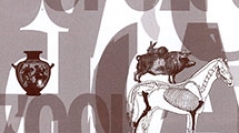

 Anthropozoologica
48 (2) - Pages 409-445
Anthropozoologica
48 (2) - Pages 409-445The recent archaeological excavations in Alsace (France) and on the left bank of the upper Rhine show the importance of the man-animal relations in the Merovingian funerary world. Their results require a regional archeozoologic synthesis. The typology of the faunal remains is very diverse: animal amulets, Associated Bone Groups, food offerings. The funerary groups delivering of the faunal vestiges are listed here in an exhaustive way and their data are sometimes re-examined. The animal amulets call upon the wild species and more frequently relate to the female tombs and the tombs of children. The geographical origins of these artifacts testify to the practice of remote commercial bonds at Merovingian. The area of the upper Rhine delivers some dogs’ Associated Bone Groups, equids, cervids, which constitute the specimens among the southernmost known for the time in Europe. The frequency of the animal offering in Alsace is often quite higher than what is observed elsewhere in Merovingian Gaul, since approximately 24% of the 469 studied tombs contain at least one animal food offering. For the early Middle Age, the animal offerings belong exclusively to domestic species, whose respective proportions significantly vary from one funerary group to another. However the pig (Sus domesticus), the hen (Gallus gallus domesticus) and the eggs constitute the main part of the deposits. The analysis of the faunal remains in funerary context highlights habits in early Middle Age, often in relationship with the place of the deceased in the society and with their membership of the Germanic cultural sphere. The decoding of those funeral gestures is totally indivisible from the interdisciplinarity of research.
Alsace, amulets, ankle bone, Associated Bone Groups, beaver, funerary, early Middle Age, food offerings, Merovingian